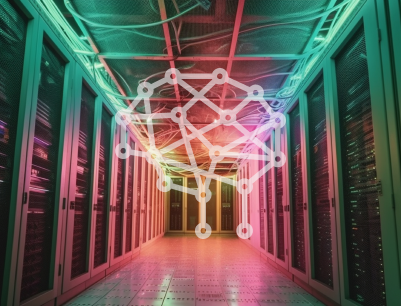AI and the Nuclear Revolution
Why Uranium is the Future
Key Generation Uranium News Highlights

Generation Uranium Secures Key Mining Permits

Breakthrough Technology Enhances Uranium Purity

Global Energy Leaders Invest in Uranium
September 1, 2024
The world is witnessing an unprecedented surge in artificial intelligence (AI) development, transforming industries and daily life.
From data centers processing massive datasets to machine learning algorithms running complex models, AI's footprint is expanding rapidly.
However, this technological revolution comes with a significant caveat: AI's growing energy consumption.
As AI applications proliferate, the demand for electricity to power these systems is skyrocketing.
Data centers, the backbone of AI infrastructure, are becoming one of the largest consumers of electricity worldwide.
Training a single advanced AI model can consume as much energy as hundreds of households do in a year.
Autonomous systems, such as self-driving cars, also require substantial energy to operate efficiently and reliably.
The future projections for AI's energy consumption are staggering.
With the integration of AI into more facets of the economy and everyday life, energy demand is expected to increase exponentially.
This surge in energy consumption poses a significant challenge, as traditional energy sources may not be sufficient or sustainable to meet these demands.
Nuclear energy, powered by uranium, presents a viable solution to this impending energy crisis.
Unlike fossil fuels, nuclear power offers a high-energy output with minimal environmental impact.
Uranium, the key element in nuclear energy production, is abundant and highly efficient, making it an ideal candidate to support the AI revolution.
In this article, we will explore the intricate relationship between AI and energy consumption, highlighting why uranium and nuclear power are poised to meet the future's energy needs effectively.
We will delve into the advantages of uranium, the role of AI in enhancing nuclear technologies, and the economic and environmental benefits of this synergy.
By understanding the critical intersection of AI and nuclear energy, we can pave the way for a sustainable and powerful future.

The Energy-Hungry Nature of AI
The rapid advancement of AI technologies has led to a dramatic increase in energy consumption.
AI applications, particularly those involving large-scale data processing and machine learning, require substantial computational power, which in turn demands significant amounts of electricity.
Data centers, which host the servers running AI algorithms, are among the largest consumers of electricity.
These facilities must operate 24/7, ensuring reliable and uninterrupted service.
A 2019 study found that data centers consumed about 1% of the world's electricity, a figure that is expected to grow as AI technologies proliferate (Science).
Machine learning, a core component of AI, is particularly energy-intensive.
Training a state-of-the-art machine learning model can involve billions of calculations, requiring extensive computational resources.
For instance, training the popular natural language processing model, GPT-3, consumed as much electricity as 126 typical American homes use in a year (Association for Computational Linguistics (ACL)).
Autonomous systems, such as self-driving cars, also contribute to the rising energy demands.
These systems rely on continuous processing of data from various sensors and cameras to make real-time decisions.
This constant data processing and communication between vehicles and data centers require substantial energy.
The energy consumption of AI is not limited to data centers and autonomous systems.
Internet of Things (IoT) devices, smart cities, and other AI-driven applications further exacerbate the demand for electricity.
As AI becomes more integrated into everyday life, the overall energy consumption is expected to increase exponentially.
The environmental impact of this surge in energy consumption is significant.
The majority of data centers still rely on fossil fuels for electricity, contributing to greenhouse gas emissions and climate change.
To mitigate these effects, there is an urgent need to explore sustainable and efficient energy sources capable of supporting AI's growth.
Nuclear energy, particularly through the use of uranium, offers a promising solution.
Unlike fossil fuels, nuclear power provides a high-energy output with minimal carbon emissions, making it an environmentally friendly option.
Moreover, the efficiency and reliability of nuclear energy can meet the large-scale energy demands of AI technologies effectively.
As we move forward, integrating AI with sustainable energy sources like nuclear power will be crucial in managing the environmental and economic impacts of AI's energy consumption.
In the following sections, we will delve deeper into the advantages of uranium, the role of AI in enhancing nuclear technologies, and the economic and environmental benefits of this synergy.
Nuclear Energy: Meeting AI's Demands
As AI continues to drive technological progress, the demand for a stable and high-capacity energy source is more pressing than ever.
Uranium, used in nuclear power generation, emerges as the ideal solution to meet these increasing energy needs.
Nuclear power plants, fueled by uranium, operate with a high capacity factor.
This means they can produce electricity at full power for a larger percentage of the time compared to renewable energy sources like wind or solar (World Nuclear Association).
The efficiency of nuclear energy is unparalleled.
A single uranium fuel pellet, roughly the size of a pencil eraser, can produce as much energy as one ton of coal or 17,000 cubic feet of natural gas..
This high energy density means that nuclear power can generate vast amounts of electricity from a relatively small amount of fuel, making it an ideal candidate to support the burgeoning energy needs of AI technologies.
Moreover, nuclear power plants operate with a high capacity factor, meaning they can produce electricity at full power for a larger percentage of the time compared to renewable energy sources like wind or solar.
This reliability is crucial for AI applications, which require consistent and uninterrupted power supply to function effectively.
Nuclear energy is not only efficient but also environmentally friendly.
Unlike fossil fuels, nuclear power generates minimal greenhouse gas emissions during operation, significantly reducing the carbon footprint associated with energy production.
This makes it a sustainable option for meeting future energy demands without exacerbating climate change.
In addition to its current capabilities, advancements in nuclear technology promise even greater efficiency and safety.
Next-generation reactors, such as Small Modular Reactors (SMRs) and Generation IV reactors, are being developed to offer enhanced safety features, lower costs, and improved waste management solutions.
These innovations ensure that nuclear power will continue to be a viable and safe energy source for the foreseeable future.
As we integrate AI more deeply into our economy and daily lives, the need for a stable and scalable energy source becomes increasingly critical.
Nuclear power, with its high efficiency, reliability, and low environmental impact, is well-positioned to meet these demands.
By leveraging the power of uranium, we can ensure that the AI revolution is supported by a sustainable and robust energy infrastructure
(World Nuclear Association).
Uranium: The Ideal Energy Source for AI
As AI continues to drive technological progress, the demand for a stable and high-capacity energy source is more pressing than ever.
Uranium, used in nuclear power generation, emerges as the ideal solution to meet these increasing energy needs.
Nuclear power plants, fueled by uranium, operate with a high capacity factor.
This means they can produce electricity at full power for a larger percentage of the time compared to renewable energy sources like wind or solar (World Nuclear Association).
This reliability is crucial for AI applications, which require a consistent and uninterrupted power supply to function effectively.
Environmental benefits are another significant advantage of uranium.

As AI continues to drive technological progress, the demand for a stable and high-capacity energy source is more pressing than ever.
Uranium, used in nuclear power generation, emerges as the ideal solution to meet these increasing energy needs.
Nuclear power plants, fueled by uranium, operate with a high capacity factor.
This means they can produce electricity at full power for a larger percentage of the time compared to renewable energy sources like wind or solar (World Nuclear Association).
This reliability is crucial for AI applications, which require a consistent and uninterrupted power supply to function effectively.
Environmental benefits are another significant advantage of uranium.
Economic and Environmental Benefits
Nuclear energy, fueled by uranium, offers significant economic and environmental advantages over fossil fuels, making it a compelling choice for powering the AI revolution.
One of the key economic benefits of nuclear energy is its low operational cost once the plants are constructed.
Although the initial capital investment for building nuclear power plants is high, the cost of maintaining and operating these plants is relatively low compared to fossil fuel plants.
This makes nuclear energy a cost-effective solution in the long run, particularly as fossil fuel prices continue to fluctuate (IEA).
Nuclear power plants provide a stable and reliable source of energy.
They have high capacity factors, meaning they can operate at maximum output for a larger percentage of the time compared to renewable energy sources like wind and solar.

This reliability is crucial for AI applications, which require a consistent and uninterrupted power supply to function effectively.
By reducing the dependency on fossil fuels, nuclear power helps stabilize energy prices and ensures energy security (IEA).
From an environmental perspective, nuclear energy is a low-carbon energy source.
Unlike coal and natural gas plants, nuclear reactors do not emit greenhouse gasses during operation.
This significantly reduces the carbon footprint associated with energy production, which is essential for combating climate change.
Over the past 50 years, nuclear power has avoided nearly 70 gigatonnes of carbon dioxide emissions globally, highlighting its critical role in reducing greenhouse gas emissions (IEA).
In addition to reducing emissions, advancements in nuclear technology are making nuclear power even safer and more efficient.
Innovations such as Small Modular Reactors (SMRs) and Generation IV reactors offer enhanced safety features, lower costs, and better waste management solutions.
These advancements ensure that nuclear power remains a viable and safe energy source for the foreseeable future.
The economic and environmental benefits of nuclear energy make it an ideal choice to support the growing energy demands of AI technologies.
By investing in nuclear power, we can ensure a stable, reliable, and sustainable energy supply that supports economic growth and environmental sustainability.
Future Prospects: A Sustainable Energy Future with AI and Uranium
The integration of AI and nuclear energy holds significant promise for creating a sustainable and efficient energy future.
Predictions for the integration of AI into nuclear energy systems suggest that AI can greatly enhance the efficiency and safety of nuclear power plants.
AI technologies can optimize reactor operations, improve predictive maintenance, and enhance safety protocols.
These advancements are crucial as we aim to meet the increasing energy demands driven by AI applications while ensuring minimal environmental impact (IEA).
Global policies and international cooperation play a vital role in the expansion and acceptance of nuclear energy.

Countries around the world are recognizing the importance of nuclear power in achieving net zero emissions by 2050.
Policies that support the development of advanced nuclear technologies, such as Small Modular Reactors (SMRs), and international agreements on safety standards and waste management are essential.
Such cooperation ensures that nuclear power can be a reliable and safe component of the global energy mix (IEA).
The vision for a sustainable energy future powered by AI and uranium involves a diverse and resilient energy system.
By combining nuclear power with renewable energy sources, we can create a balanced and low-carbon energy infrastructure.
Nuclear power's ability to provide stable and high-capacity energy makes it a crucial player in this future.
The integration of AI will further enhance the operational efficiency and safety of nuclear plants, ensuring that they can meet the growing energy demands without compromising on environmental goals (IEA).
In conclusion, the synergy between AI and nuclear energy presents a transformative opportunity for the global energy landscape.
By leveraging uranium's high energy density and the technological advancements of AI, we can achieve a sustainable, efficient, and low-carbon energy future.
Robust policies, international cooperation, and continuous innovation are key to realizing this vision.
Conclusion: The Path Forward
The convergence of AI and nuclear energy presents an unparalleled opportunity for sustainable progress.
Uranium-powered nuclear energy is essential for meeting the rising energy demands driven by AI technologies.
Its high energy density, minimal greenhouse gas emissions, and technological advancements make it a superior choice over traditional fossil fuels.
Nuclear power ensures a stable and reliable energy supply, crucial for the uninterrupted operation of AI applications.
Investing in uranium-based nuclear energy supports both economic growth and environmental sustainability.
As we transition to a cleaner energy future, the role of nuclear power becomes increasingly vital.
Stakeholders must recognize the necessity of adopting uranium-powered nuclear energy to support the AI revolution.
This synergy offers a transformative solution to our energy challenges, promising a stable, efficient, and low-carbon future.
We call on policymakers, industry leaders, and investors to embrace this promising synergy.
By investing in nuclear power and integrating AI, we can achieve significant advancements in energy efficiency and sustainability.
Together, we can power the future, ensuring a robust and resilient energy infrastructure that supports ongoing technological innovation and environmental stewardship.
Subscribe for the Latest Generation Uranium Investor Updates
Subscribe for the Latest on
Generation Uranium's Advancements
Office: 6th Floor,
905 W Pender St,
Vancouver, BC
V6C 1L6
Email: [email protected]

